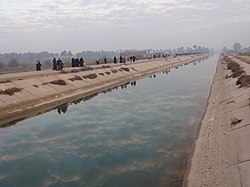Al-Hindiya District
| Al-Hindiya District | |
|---|---|
| District | |

Euphrates canal in Hindiya
|
|
| Coordinates: 32°32′27″N 44°10′29″E / 32.540801°N 44.174617°ECoordinates: 32°32′27″N 44°10′29″E / 32.540801°N 44.174617°E | |
| Country |
|
| Governorate | Karbala Governorate |
| Elevation | 30 m (100 ft) |
| Population 2013 | |
| • Total | 360,000 |
| Time zone | AST (UTC+3) |
Al-Hindiya District (Arabic: قضاء الهندية Kaza Al-Hindiya)is a district of the Karbala Governorate, Iraq. Its largest town is Al-Hindiya, to the east of Karbala. The Hindiya Barrage in the north of the district controls floods and diverts water from the Euphrates into irrigation canals on both sides of the river. The district has been the scene of clashes with Turkish and British colonial forces, and more recently with American troops in 2003. The population is about 230,000, mostly Shia, including significant numbers of refugees. Infrastructure is poor, but efforts are being made to improve it.
The district is the easternmost of Karbala Governorate and is bordered by Babil Governorate to the east. It lies to the south of Baghdad and west of ancient Babylon. The Euphrates flows through the district from north to south. The principal town is Al-Hindiya, which lies on the road from Karbala to the west and Hillah to the east. The district is at an altitude of about 30 metres (98 ft) above sea level. Observations of rainfall at Hindiya in the 1920s and 1930s gave a mean annual precipitation of 160 millimetres (6.3 in), but there were wide variances from a maximum of 568 millimetres (22.4 in) to a minimum of 37 millimetres (1.5 in).
The Hindiya district in the Ottoman era, which then covered a larger area of the lower Euphrates, was a rich source of grain. The peasants often paid tax in kind, in the form of barley, wheat and corn. In 1848 Najib Pasha triggered a rebellion that lasted two years by demanding excessive taxation. The government lost control of the countryside and its troops were confined to towns such as Karbala, Najaf and Hilla.
Writing of an 1849 expedition to explore the ruins of Ninevah and Babylon, Sir Austen Henry Layard reported that the large canal called the Hindiyah now led almost half the waters of the Euphrates into huge marshes west of Babylon. The Arabs had driven their buffaloes into the wetlands to escape the attention of the Turks. Abde Pasha was trying to dam the mouth of the canal and dry out the marshes. The current was washing away the earth and fascine barrier as fast as it could be built.
...
Wikipedia

